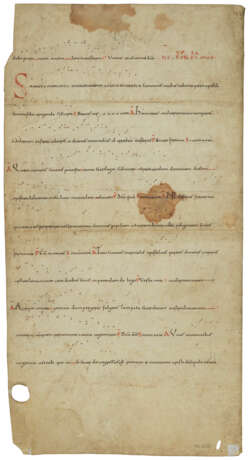ID 1053124
Los 10 | Aquitanian neumes
Schätzwert
£ 5 000 – 8 000
A leaf from an Antiphonal, in Latin, manuscript on vellum [Abbey of St Martial, Limoges, c.1030]
A fascinating product of the Abbey of St Martial in Limoges, arguably the most important scriptorium for the history and development of liturgical music in the Middle Ages, made at the time of its greatest significance and reflecting a particularly interesting moment in its history.
c.372 x 195mm, 12 lines written in brown ink in an extremely elegant Carolingian minuscule, ruled space: c.268 x 168mm, rubrics in red with some incipits in rustic capitals, 12 lines of early Aquitanian neumes on a 1-line ruled F-staff, four initials in red or brown (some darkening in the margins, a few stains, some fading of a few lines, two original holes to lower margin). Bound in grey buckram.
Provenance:
(1) The parent manuscript was produced in the Benedictine Abbey of St Martial in Limoges: the Office of St Martial on the recto of the present leaf opens: 'Venerandam beatissimi patronis nostri [...]'.
St Martial de Limoges was founded in 848 at the site of the tomb of the first (3rd century) Bishop of Limoges. 'Among the French abbeys that were centres of musical and poetic activity from the 9th century to the 12th, none has left so rich a store of musical material [...]' (A. E. Planchart, 'St Martial', Grove Dictionary of Music and Musicians, 16, p.396). The monastery was secularised in 1535; in 1730 manuscripts from the Abbey were sold to the Bibliothèque Royale. The monastery was dissolved in 1781 and demolished in 1792. All but a handful of the surviving manuscripts from St Martial are in the Bibliothèque Nationale de France. Only one Antiphonal from St Martial is listed by Gaborit-Chopin: Paris, Bibliothèque Nationale de France, latin 1085 (G. Gaborit-Chopin, 'La Décoration des manuscrits à Saint-Martial de Limoges et en Limousin du IXe au XIIe siècle', Mémoires et documents publiés par la Société de l'École des Chartes, 17, 1969, pp.184-5).
(2) The leaf may have served as a wrapper for an account book: an inscription along the inner margin of the recto appears to read 'Comptes 1509'.
(3) Private Collection, Oxford.
(4) Sam Fogg Rare Books Ltd., acquired in 1990 by:
(5) Schøyen Collection, MS 658.
Text:
The recto carries the antiphons and versicles from the Office of St Paul, the Common of an Evangelist, and the Common of a Confessor, followed by the antiphons and psalm incipits with the appropriate psalm tone endings for the Office of St Martial at the first Vespers; from '[Sancte Paule apostole, praedicator veritatis, intercede pro nobis] ad Deum qui te helegit' to 'quo viso sacer dei regressus est Romam et nunciavit Christi discipulo omnia [que sibi in via contigerant]'.
The form of the Office of St Martial on the present leaf indicates a date of c.1030. Towards the end of the 10th century, a legend grew up claiming the apostolicity of the Saint. This was fervently and successfully, although apparently deviously, promoted by the Abbey's chronicler Adémar de Chabannes (988-1034). St Martial the Confessor and Bishop was proclaimed as an Apostle of Christ at a series of celebrated church councils held between 1028 (Limoges) and 1031 (Bourges). The Abbey's prestige was thus greatly enhanced. In support of these claims and, after the proclamation, to consolidate the new status of the patron, the Masses and Offices in honour of him and his associates were modified at this time (see J. A. Emerson, 'Two newly identified offices for saints Valerie and Austriclianus by Adémar de Chabannes', Speculum (1965), pp.31-46 and J. Grier, The Musical World of a Medieval Monk: Adémar de Chabannes in Eleventh-century Aquitaine, 2006, ch.3).
Script and music:
Details of the script - for example, the open-bowled 'g' with angled descender, the use of the ligature st both in the middle and at the end of words - the form of the neumes with their disposition around a single horizontal ruled line representing the pitch 'F' (a decisive advancement in the development of notation), all conform with St Martial manuscripts produced at the end of the 10th and the beginning of the 11th century. The Aquitanian point neumes present here are a fine example of the clarity and precision of this particular notation. It was in widespread use in the south of France, and from its very inception, the scribe organised the neumes according to pitch above and below an imaginary line. In time, towards the end of the 10th century, the text copyist was using one of two dry-point lines scratched on the parchment; the musical copyist made use of the second line as a centre-line, usually placing it on the 3rd of an authentic mode or the final of a plagal mode.
| Herkunftsort: | Frankreich |
|---|---|
| Kategorie des Auktionshauses: | Handschriften des Mittelalters und der Renaissance |
| Herkunftsort: | Frankreich |
|---|---|
| Kategorie des Auktionshauses: | Handschriften des Mittelalters und der Renaissance |
| Adresse der Versteigerung |
CHRISTIE'S 8 King Street, St. James's SW1Y 6QT London Vereinigtes Königreich | ||||||
|---|---|---|---|---|---|---|---|
| Vorschau |
| ||||||
| Telefon | +44 (0)20 7839 9060 | ||||||
| Aufgeld | see on Website | ||||||
| Nutzungsbedingungen | Nutzungsbedingungen |




